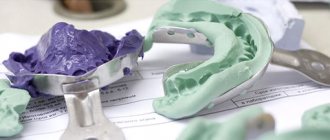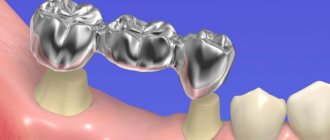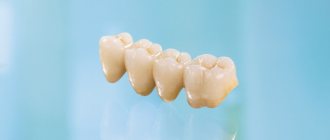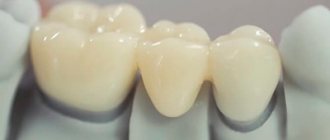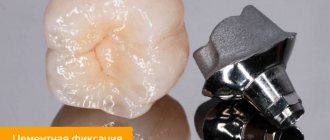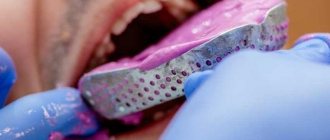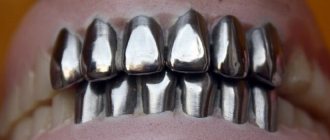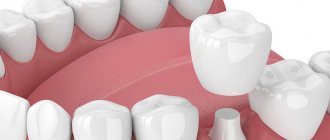The widespread introduction of casting technology into the practice of dental laboratories has allowed foundry specialists to make thin-walled and high-precision solid-cast crowns from metals and medical alloys, designed to eliminate obvious defects in the dentition.
Such prosthetic devices are widely used in modern dental practice to restore the natural anatomical shape of damaged teeth or as supporting and fixing elements for prosthetic structures.
Indications for placing solid crowns
The most common indications for the use of solid dental crowns in dental practice are:
- significant damage to the crown parts of the teeth;
- unconscious and unreasonable contractions of the masticatory muscles;
- anomalies in the position, size and shape of natural teeth;
- the need to place fixing and supporting clasps on the teeth;
- pathologies of occlusion and bite;
- bruxism;
- pathological abrasion of teeth.
Kinds
A solid metal crown can be made from different materials.
Such products can be:
- metal with spraying,
- without spraying,
- with lining,
- combined bridge prosthesis.
The design without coating does not look very aesthetically pleasing; it is made of polished metal. It has a relatively low price, but not everyone is happy with it.
If aesthetics are important to the patient, then you should choose a crown with a coating that imitates gold. They look more attractive, but you should be careful when spraying: it can have a negative effect on the mucous membrane.
A one-piece crown with ceramic lining is perhaps the most aesthetic option of the three already presented - it has an overlay made of ceramic or plastic, which is located on its front surface. Of course, the pad also needs to be treated with care, because it is made of fragile materials, but if you follow the rules of care, it will last a long time.
A combined prosthesis is created from several metal-ceramic crowns that cover the smile area, and from solid polished crowns.
The procedure for prosthetics with solid-cast crowns
All video presentations
The process of installing solid crowns consists of several stages:
- 1. preparation for prosthetics (sanitation of the patient’s oral cavity, treatment of pulpitis, dental caries, root canal filling);
- 2. grinding of the abutment tooth;
- 3. making impressions and transferring them to the laboratory for making a mold for casting a prosthetic structure;
- 4. crown casting;
- 5. fitting of the finished prosthetic device;
- 6. fixation of a one-piece crown in the oral cavity.
The main materials used for the manufacture of solid crowns are:
- cobalt chromium alloy;
- alloys with high titanium content;
- chromium-nickel alloy;
- noble alloys (containing precious metals).
Gold plating
In cases where the patient does not like the shiny polished surface of a metal or alloy, an additional “gold-like” layer is sprayed onto the crown. Meanwhile, some dentists note that sprayed prosthetic devices can have a negative effect on the epithelial tissues of the oral cavity.
Ceramic coating
If necessary, the patient can order the production of a one-piece prosthetic device with veneer: in this case, the front part of the crown is made of ceramic. Meanwhile, such models are significantly inferior in reliability to all-metal products.
Arguments for and against cast structures
In addition to the objective, today there is also a preconceived opinion about a solid-cast crown: that it is a product that has no advantages other than a low price. Of course this is not true. The main advantage of the design is durability: with proper installation and proper care, it can last more than 15 years. To present in detail the advantages of cast prostheses, let us compare them in a number of indicators with stamped ones (that is, created not individually, but from a template):
- tight fit: stamped structures are made from factory blanks, which are given an approximate shape using mechanical processing. It is impossible to install such a product tightly to the tooth surface - hence the ingress of food particles under the denture, the proliferation of bacteria, and the development of inflammatory processes. Cast products have high anatomical accuracy, so such problems are excluded,
- strength: the stamping is thin, therefore, under the influence of loads and chemical reactions in the oral cavity, it gradually collapses. After some time, a through hole is formed, opening access to infection. The result is the development of secondary caries, followed by pulpitis. The thickness of the solid crown is 0.3-0.5 mm. This is enough to successfully withstand both mechanical and chemical influences,
- safety: bridges from stamped elements are made by soldering. The connections are not very strong and often break - there is a high probability of injury. In addition, the products themselves and the solder have different compositions. This leads to the emergence of galvanic currents, which, in turn, cause irritation of the mucous membrane. Cast structures are made entirely from one alloy and do not require soldering, so such consequences do not occur.
Interesting! Stamped steel dental products are the oldest in their family. They were worn by many generations of Soviet citizens until the high toxicity of the composition, to which cadmium, beryllium, lead and other impurities harmful to health were added, was discovered. Nowadays such structures are made from a safer alloy, but in general stamping is carried out only in the deep provinces. Similar products have not been produced in any country except Russia for about 100 years.
Thanks to these properties of solid-cast crowns, both clasp and bridge systems using them will be more reliable. Surprisingly, cast metal prostheses have a number of advantages over metal-ceramic products that are popular today. The design is simpler, so it can be manufactured faster. In addition, cast metal is not at risk of chipping, as is the case with a ceramic coating. This product is also thinner than metal-ceramic, therefore, it requires less grinding of the teeth - as a result, they remain more viable.
The main disadvantage of metal prostheses is the lack of aesthetics, which today has acquired special importance. Therefore, such structures are placed only on chewing teeth, which are not very visible to others. But as soon as you laugh heartily, the alien metal will become noticeable.
“I’m 60 years old, and now I need to get my teeth done. Previously, I remember, there was no choice, but now there is nothing on offer. At first I wanted to install metal ones from casting - it doesn’t seem to be visible on the molars. Then I thought: I work as a teacher at school, constantly in public, I would still be embarrassed to talk and smile. I chose metal ceramics and I don’t regret it, I feel absolutely free.”
Vera Sergeevna, patient of one of the Moscow dental centers
Complex on 4 OSSTEM implants with delayed loading - from RUB 170,000.
Complex implantation Osstem (South Korea) with delayed loading after 4-6 months.
Guarantee for the doctor’s work - unlimited Call now or order a call
Opening hours: 24 hours a day - seven days a week
There are also more significant disadvantages. This is both a risk of developing allergies and a danger of damaging neighboring teeth, as well as those located on the opposite jaw - due to the high hardness of the metal. Therefore, if you are not too tight on funds, you should still consider more advanced prosthetic options. In particular, you can also choose a solid metal structure, but with ceramic lining (this will be discussed below).
The main advantages of solid crowns
The most important advantages of solid dental crowns are:
- the highest precision of fit of the cast inner part of the crown to the tooth stump (the width of the gaps between the inner part of the prosthetic device and the surface of the tooth does not exceed several microns, and this allows you to avoid saliva, pieces of food and pathogens getting inside the crown);
- availability of spraying on the surface of the crown;
- strength and high wear resistance of the finished crown;
- availability of opportunities to recreate the natural chewing surface of the tooth;
- restoration of the chewing function of a tooth covered with a solid crown;
- availability of opportunities to recreate optimal interdental contacts;
- biological inertness, lack of toxic effects on the tissues of the human body;
- affordable prices for the production and installation of solid crowns;
- reliability (soldering is not required for the manufacture of solid-cast crowns: the prosthesis is solid and consists of one metal or alloy, which makes it more resistant to damage);
- durability of the prosthetic device (the service life of solid-cast prosthetic devices, subject to the rules of use, can exceed 10 years).
Approximate prices
The cost of prosthetics consists of several factors, including: an x-ray image - 1000 rubles, fixation of a temporary structure until the permanent one is ready - 2000 rubles, the cast crown itself - 6000 rubles. Of course, these are approximate prices that may vary depending on the level of prestige of the clinic and region of residence. Also, the selected type of metal has a direct impact on the formation of the cost of the product - gold structures are considered the most expensive, their price starts from 15-20 thousand rubles.
South Korean implant Osstem - 20,000 rub.
Hurry up to sign up for a free consultation and lock in promotional prices.
Call now or request a call
Opening hours: 24 hours a day - seven days a week
Disadvantages of using solid crowns
The negative features of dental prosthetics using solid crowns include:
- the need to grind down a relatively large layer of surface tissue of the teeth;
- high thermal conductivity of prosthetic devices (if the pulp of the abutment tooth is close, the patient may experience severe discomfort);
- excessive abrasion of antagonist teeth during constant contact with the surface of a solid crown.
In addition, the disadvantage of such prosthetic devices is their appearance: the color of metal crowns does not match the color of natural tooth enamel. It is for this reason that they are used only for prosthetics of chewing teeth that are not noticeable when smiling and talking.
Otherwise, solid crowns fully perform their assigned tasks and are rightfully considered one of the best prosthetic devices designed to hide dentition defects.
Why are all-metal crowns losing their relevance?
Article navigation
- What is the product
- In what cases are such crowns installed?
- Arguments for and against cast structures
- What are the types of cast products?
- What materials are these crowns made from?
- How structures are produced and installed
- Approximate prices
- How to care for cast dentures
- FAQ
Question for a specialist
In Soviet times, crowns made of ordinary metal looked familiar, and gold crowns were considered chic. Today, the idea of aesthetics has changed, dentistry has stepped far forward, and many modern clinics have completely abandoned this type of prosthetics. However, solid metal crowns are still installed in a number of cases - mainly as a budget option for dentition restoration.
Read about what these structures are made of, as well as their improved types, in today’s article.
Advantages and disadvantages
Such products have the following advantages:
- High quality and the ability to manufacture a design taking into account the individual characteristics of the patient’s jaw. Products are created individually for each tooth, they follow its shape and fit tightly to the gums.
- Durability and abrasion resistance. The structures are made from durable alloys that do not wear out for a long time; they are indicated for those who have pathological tooth wear. The products have a long service life.
- Possibility to do without deep preparation. Installation of solid cast structures involves grinding the teeth by only 0.8 mm.
The disadvantages of products of this type are the following qualities:
- lack of aesthetics,
- high thermal conductivity, which can cause discomfort when eating hot food or drinks.
